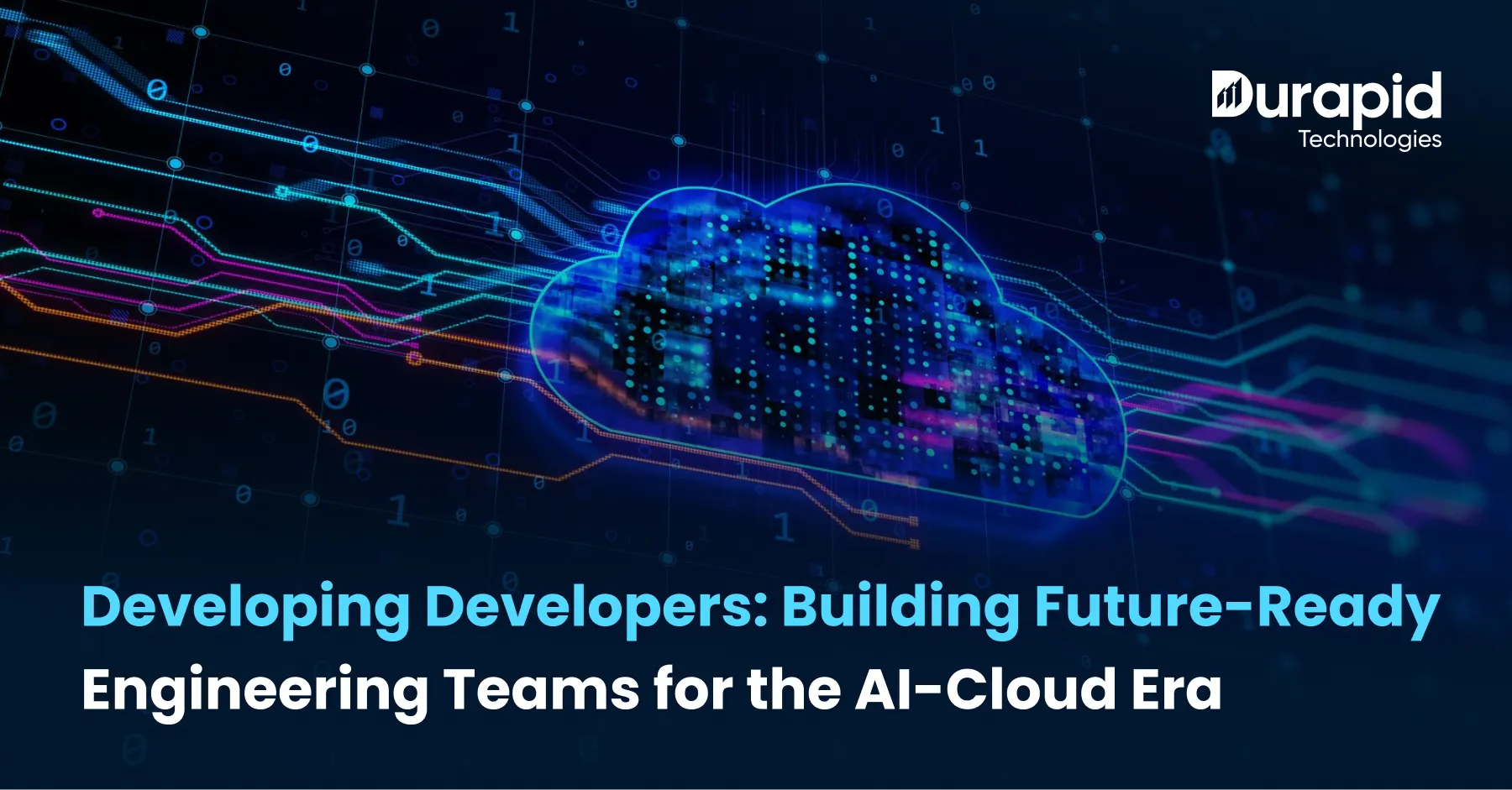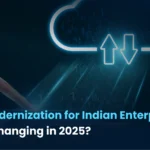Developing Developers: Building Future-Ready Engineering Teams for the AI-Cloud Era

Introduction: The Developer Landscape is Changing Faster Than Code Compiles
The truth is, software engineering has never been static. But in the AI + cloud computing era, the pace of change feels… exponential.
Here’s a harsh reality check:
- AI can now generate production-ready code.
- Cloud-native architecture is no longer “optional”, it’s the default.
- New frameworks, from Kubernetes to generative AI tooling, roll out faster than developers can update their GitHub README.
So where does this leave engineering leaders trying to build sustainable, high-performing teams?
It’s simple in theory, brutal in practice: You need future-ready engineering teams.
At Durapid Technologies, we see this daily as we help enterprises accelerate through AI, cloud, and data engineering. It’s not just about code, it’s about building builders who thrive in this new reality.
The Context: Why “Traditional Dev Teams” Don’t Cut It Anymore
Tech stacks are evolving, but here’s the bigger challenge: developer roles themselves are shifting.
A decade ago, being a solid coder was enough. Today? Developers must:
- Design scalable cloud systems across hybrid and multi-cloud.
- Master AI for software development, from writing unit tests with Copilot to experimenting with prompt engineering.
- Understand DevOps principles for continuous integration + delivery.
- Collaborate across business, security, and data teams like never before.
According to a Gartner report, 80% of enterprise workloads will be cloud-native by 2026. Meanwhile, McKinsey’s AI adoption study shows 70%+ companies are already experimenting with generative AI in software engineering.
Translation: Yesterday’s developer playbook isn’t just outdated, it’s borderline irrelevant.
This is exactly why enterprises are asking: How do we develop developers capable of surviving AND thriving in this AI-cloud era?
Building Future-Ready Engineering Teams: The Complete Playbook
Here’s the thing about future-ready engineering teams: they’re not built overnight. It’s not just hiring shiny new AI coders or adding a “cloud-first” keyword to job descriptions.
It’s an operating model, a strategy, that grows skills, mindsets, and systems.
But here’s what most companies get wrong: They think transformation is about tools. It’s not. It’s about humans adapting to work alongside intelligent systems while maintaining their creative edge.
Let’s break it down.
1. Core AI Developer Skills: Beyond Just Writing Code
When we talk about AI developer skills, too many people think: “Oh, they just need to know how to use ChatGPT.”
That’s like saying being a chef means knowing how to use a microwave.
Future-ready developers need three AI pillars:

a. Understanding AI as a collaborator, not a crutch
- Using AI for software development responsibly (AI-assisted debugging, test case generation, API documentation).
- Knowing when not to trust the bot (hallucinations are real).
- Building AI-assisted workflows that amplify human decision-making, not replace it.
The reality check: Developers who blindly trust AI suggestions introduce more bugs than they prevent. Smart developers use AI like a junior pair programmer—helpful, but always double-checked.
b. Mastering Prompt Engineering
- Clear, contextual prompts to guide generative AI.
- Engineering logic statements that get accurate, reproducible outputs.
- Understanding prompt chaining and context window management.
- Building reusable prompt templates for common development tasks.
Pro tip: The best prompt engineers think like API designers. They create structured inputs that generate predictable outputs.
c. AI lifecycle literacy
- Awareness of data pipelines, model training, and AI ethics.
- Understanding how AI integrates with cloud workflows (Azure ML, AWS Sagemaker, Google Vertex).
- Recognizing bias in training data and implementing fairness checks.
- Building observability into AI-powered features (monitoring model drift, performance degradation).
The deeper truth: Developers who understand the full AI stack—from data ingestion to model deployment—build more robust, maintainable AI applications.
Durapid Blog: AI in Application Development goes deeper into practical AI adoption.
2. Cloud Computing Skills: The Foundation Every Developer Needs
If AI is the brain, cloud computing skills are the nervous system.
But here’s what’s changed: Cloud isn’t just about “moving servers to AWS anymore.” It’s about building applications that are cloud-native from day one—applications that can scale, heal, and optimize themselves.
Tomorrow’s developer needs to know:

Cloud-Native Architectures
- Containers, microservices, Kubernetes orchestration.
- Event-driven architectures that respond to real-time data.
- Serverless computing patterns (when to use Lambda vs containers vs VMs).
- API-first design that enables composable architectures.
The shift: Developers need to think in terms of distributed systems, not monolithic applications. Every component should be independently deployable and scalable.
Security-by-Design
- Identity access, encryption, compliance standards.
- Zero-trust security models.
- Secrets management and secure coding practices.
- Automated security scanning and compliance monitoring.
Real talk: Security isn’t an afterthought anymore. With AI processing sensitive data in the cloud, security literacy is as important as coding ability.
Multi-cloud adaptability
- Deploying across AWS, Azure, and GCP depending on enterprise strategy.
- Understanding cloud-specific services and when to use abstraction layers.
- Building portable applications that avoid vendor lock-in.
- Managing data residency and compliance across regions.
Cost optimization & FinOps
- Building efficient apps that don’t blow up the CFO’s budget.
- Understanding cloud pricing models and optimization strategies.
- Implementing auto-scaling that responds to business metrics, not just technical metrics.
- Building cost awareness into development workflows.
The economics: A 10% improvement in cloud efficiency can save enterprises millions. Developers who understand FinOps become invaluable.
Even if you’re building AI products, the compute backbone = cloud. This is why essential skills for a cloud developer aren’t an add-on—they are mandatory.
Explore how Durapid enables scalable cloud transformation services.
3. Upskill Professional Development: The Hidden Superpower
Here’s the unpopular truth: It’s cheaper to upskill than to hire.
But here’s the deeper truth: It’s not just cheaper—it’s better. Your existing developers already understand your business context, your technical debt, and your customers’ pain points. New hires don’t.
Instead of endlessly searching for the perfect “AI + cloud unicorn,” leading companies are learning how to upskill developers for the AI era.
Some real, tactical strategies:
Structured Learning Pathways
- Microlearning modules → Bite-size courses on prompt engineering, Generative AI APIs.
- Progressive skill building → Start with fundamentals, build to advanced use cases.
- Certification tracks that align with career progression.
- Personalized learning paths based on current skill gaps and role requirements.
The key: Make learning feel like career advancement, not homework.
Safe Learning Environments
- Sandbox environments → Let devs play with new tools without fear of crashing production.
- Hackathons focused on AI + cloud integration.
- Innovation time (20% projects) specifically for experimenting with emerging tech.
- Failure-friendly environments where breaking things in dev is celebrated as learning.
Collaborative Learning Models
- Pair programming with AI + humans → Reduce resistance, boost adoption.
- Cross-team rotations (cloud, DevOps, data engineering) → Build generalists who can specialize.
- Internal tech talks where early adopters share wins and failures.
- Mentorship programs pairing AI/cloud experts with traditional developers.
The multiplier effect: When one developer learns something new and teaches five others, your investment multiplies 5x.
Measuring Learning Impact
- Skill assessments before and after training programs.
- Project-based evaluations where developers apply new skills to real work.
- Career progression tracking tied to skill development.
- Business impact metrics (faster delivery, fewer bugs, improved performance).
This is how you start building a future-proof tech team, one sprint at a time.
Check Durapid’s Enterprise Learning & Enablement solutions.
4. DevOps + Culture: It’s Not Tools, It’s Team Mindset
Let’s talk about DevOps.
Your CI/CD pipeline may have the fanciest integration, but unless your developers adopt a culture of continuous improvement, you’re just automating chaos.
But here’s what’s evolved: DevOps isn’t just about faster deployments anymore. It’s about building systems that learn, adapt, and self-heal—with AI as a core component.
Future-ready teams bake in:
Psychological Safety at Scale
- Devs aren’t scared to break things in staging.
- Blame-free post-mortems that focus on system improvements, not individual mistakes.
- Transparent metrics that show team performance, not individual performance.
- Leadership that celebrates intelligent failures and rapid recovery.
The psychology: Fear kills innovation. Teams that feel safe to experiment move faster and build better products.
AI-Enhanced DevOps Workflows
- Shared ownership → ops + devs + AI models are one loop.
- AI-assisted code reviews that catch security vulnerabilities and performance issues.
- Intelligent alerting that reduces noise and focuses on actionable issues.
- Predictive scaling based on usage patterns and business events.
Rapid Feedback Loops
- AI-assisted testing + real-time dashboards.
- Continuous deployment with intelligent rollback capabilities.
- Real-time performance monitoring that triggers automatic optimizations.
- Customer feedback loops that influence development priorities.
The acceleration: When feedback loops are measured in minutes instead of days, development velocity increases exponentially.
Cross-Functional Collaboration
- Product, engineering, and operations working as integrated teams.
- Shared metrics and goals that align everyone toward business outcomes.
- Regular cross-team retrospectives and knowledge sharing.
- Customer-facing teams participating in technical decisions.
The Data + AI Integration Layer
Here’s what most companies miss: AI isn’t just a feature you add to existing applications. It’s a new layer that touches every part of your technology stack.
5. Data Engineering as a Core Skill
- Building pipelines that feed AI models with clean, relevant data.
- Understanding data lineage and how changes upstream affect AI performance.
- Implementing data quality checks and monitoring.
- Designing schemas that support both traditional analytics and AI workloads.
MLOps: The New DevOps
- Version control for models, not just code.
- Continuous integration for AI models (training, validation, deployment).
- A/B testing frameworks for AI features.
- Model monitoring and automatic retraining workflows.
The reality: AI applications require different operational practices than traditional software. Teams that master MLOps build more reliable AI products.
Ethics and Governance
- Building bias detection into AI development workflows.
- Implementing explainable AI practices for regulated industries.
- Creating governance frameworks for AI decision-making.
- Training teams to recognize and mitigate AI risks.
6. The Platform Engineering Revolution
The most advanced teams aren’t just building applications—they’re building platforms that enable other teams to build applications faster.
Internal Developer Platforms
- Self-service environments where developers can provision resources instantly.
- Standardized templates for common application patterns.
- Built-in security, monitoring, and compliance guardrails.
- AI-assisted development tools integrated into the platform.
API-First Architectures
- Every service exposes well-documented APIs.
- Composable architectures where teams can mix and match services.
- Event-driven patterns that enable real-time integrations.
- GraphQL layers that simplify complex data relationships.
The leverage: Platform teams enable 10x productivity gains across the entire engineering organization.
7. Use Case: Building AI-Cloud Teams in Practice
Here’s a real scenario (anonymized for confidentiality):
Challenge: A large financial firm needed to migrate critical apps to cloud, introduce AI automation, but their dev teams had legacy skill sets. They had 200+ developers comfortable with on-premises Java applications, but zero experience with cloud-native architectures or AI integration.
The deeper challenge: This wasn’t just a technical problem. The team was skeptical about AI (“it’s just hype”), worried about job security, and overwhelmed by the pace of change.
Solution: Durapid created a structured program that addressed both skills and mindset:
Phase 1: Foundation Building (Weeks 1-4)
- AI literacy and prompt engineering bootcamps.
- Hands-on workshops building simple AI features.
- “AI in Finance” use case studies to show relevant applications.
- Psychological safety sessions addressing AI concerns and career paths.
Phase 2: Technical Skills (Weeks 5-10)
- Hands-on Kubernetes + cloud-native workshops.
- Migration labs using their actual applications.
- Security and compliance training specific to financial services.
- Pair programming sessions with cloud-native experts.
Phase 3: Culture Transformation (Weeks 11+)
- Embedded DevOps culture change (with AI-assisted CI/CD).
- Cross-functional team formations.
- Customer feedback integration into development workflows.
- Continuous learning programs and internal tech talks.
Phase 4: Advanced Integration (Months 4-6)
- MLOps practices for AI model deployment.
- Advanced cloud architectures (multi-region, disaster recovery).
- Platform engineering to enable other teams.
- Leadership development for technical leads.
Impact: Within 6 months, the firm’s developer productivity jumped by 43%, cloud costs dropped 27%, and AI-augmented automation saved ~20 hours/week/team.
But the real impact: Developer satisfaction increased by 60%. Teams that were previously resistant to change became champions of innovation.
Lesson: Don’t just add tech. Evolve the teams building that tech.
8. The Continuous Evolution Model
Here’s the final piece most companies miss: Building future-ready teams isn’t a project with an end date. It’s a continuous evolution process.
Learning as a Competitive Advantage
- Regular skill assessments and gap analyses.
- Technology radar sessions to identify emerging trends.
- Experimentation budgets for trying new tools and approaches.
- External learning partnerships with universities and technology vendors.
Adaptation Frameworks
- Regular retrospectives on what’s working and what isn’t.
- Flexible team structures that can reorganize around new challenges.
- Cross-industry learning (what can finance learn from gaming? what can healthcare learn from e-commerce?).
- Customer-driven innovation cycles that keep teams focused on real problems.
The Long Game
Building future-ready engineering teams isn’t about predicting the future—it’s about building teams that can adapt to any future.
The companies that win won’t be the ones with the best AI or the most advanced cloud infrastructure. They’ll be the ones with teams that can learn, adapt, and innovate faster than the competition.
Common Pitfalls When Upskilling Developers
- Tool Overload – throwing 20 AI tools at teams without process leads to burnout.
- Zero Context Training – generic courses with no project-based approach never stick.
- Ignoring Generational Mix – Gen Z coders adopt AI faster; senior devs often resist. Balance both.
- Over-indexing on AI skills but neglecting cloud fundamentals (recipe for fragile apps).
Conclusion: The Future Isn’t AI vs Human—it’s AI + Human + Cloud
Future-ready engineering teams aren’t about replacing coders with copilots.
They’re about developers who understand AI, master cloud skills, and thrive in hybrid human-machine workflows.
At Durapid, we believe this:
The future belongs to teams that continuously learn, continuously adapt, and continuously build.
That’s how you truly create future-ready engineering teams for the AI-cloud era.
Call to Action
Want to upskill your developers or build a future-proof tech team?
Start a free consultation with Durapid’s cloud + AI experts today.
FAQs: Future-Ready Engineering Teams
Q1. How to upskill developers for the AI era effectively?
The key is project-based learning. Focus on AI developer skills like prompt engineering + code automation alongside live cloud-native projects. Pair AI learning with DevOps and Kubernetes adoption.
Q2. What are the essential skills for a cloud developer?
- Cloud-native architecture (Kubernetes, microservices).
- Security-first design.
- Multi-cloud deployment.
- Cost management (FinOps).
Q3. Is using AI for software development safe?
Yes, if done responsibly. AI boosts productivity in debugging, code generation, and test automation. But always implement human-in-the-loop reviews to avoid errors from hallucinations.
Q4. What does building a future-proof tech team look like?
It means blending AI literacy, cloud computing skills, and DevOps mindsets with ongoing professional development. Future-proofing = adaptability, not a static skill list.
Q5. Which industries benefit most from future-ready engineering teams?
Every sector, finance, healthcare, retail, logistics. If your business runs on software (and spoiler: every business does), you need developers equipped for AI + cloud.





